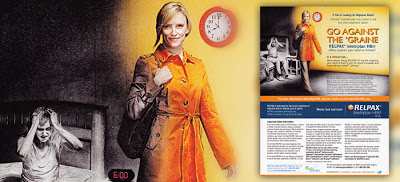The “DDR on DTC” column in the August 2012 issue of MM&M magazine ripped into a print ad that showed a woman migraine sufferer being able to mop the floor after taking the Pfizer anti-migraine headache drug Replax.
“DTC ads used to be over-aspirational,” said the author, Deborah Dick-Rath, “we saw relieved arthritis sufferers running marathons or playing Frisbee. With Relpax, the insight seems to be that sufferers just aspire to do such everyday activities as mopping the floor…We hope that Relpax is a success for Pfizer and that migraine sufferers find relief. We also hope they get (strictly aspirationally) excused from swabbing the deck” (see “DDR on DTC: Relpax“).
Here’s the ad that DDR reviewed:
This is probably the result of Pfizer’s conservative view of what modern women aspire to at 11:00 Am in the morning (note the clock).
I couldn’t find this ad in a recent issue of People Magazine, which is the publication in which DDR found the above ad. Instead I found this much more politically correct, although still not too inspirational, ad:
In this version, two hours after taking Replax, the migraine sufferer is able to go out and do whatever her business is — probably commuting to work given that the clock is showing 8;00 AM (or is it PM?).
Perhaps Pfizer read DDR’s column and revised the print ad campaign, at least as far as image is concerned. Surprisingly, however, the Replax.com Web site still portrays the woman mopping the floor:
It appears that it takes longer to swap out a Web image that a print ad image.
Pfizer is asking Replax.com visitors to tell their “stories” by submitting photos or video.
“Tell us about your experience with migraines by submitting a story,” says the promo page (here). “Your story can include a photo or video. If chosen, your submission could be featured on RELPAX.com.”
I don’t imagine a single submitted photo or video will feature a woman mopping the floor. Do you?
You can tell that pharma marketers are getting desperate when they have to beg consumers to submit stories to compensate for the fact that their image of the modern consumer dates back to the 1950’s.











![6 Digital Tools at the Center of Healthcare Digitalization [INFOGRAPHIC]](http://ec2-54-175-84-28.compute-1.amazonaws.com/pharma-mkting.com/wp-content/uploads/2021/04/6DigitalTools_600px-100x70.jpg)




